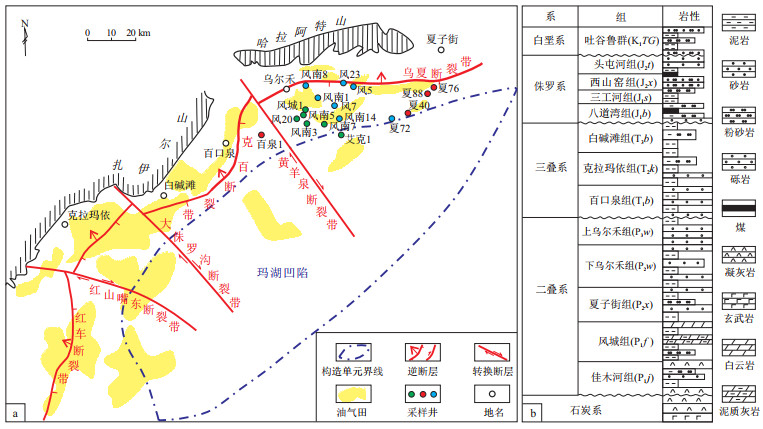Organic geochemical study of FTIR analysis on source rock extracts: a case study of Lower Permian Fengcheng Formation in Junggar Basin, NW China
-
摘要: 为进一步拓展显微傅里叶红外光谱(FTIR)技术在有机地球化学研究中的应用,以准噶尔盆地下二叠统风城组碱湖相含油气系统为例,开展了沉积有机质的生烃研究。结果表明,7组红外官能团具有指征意义,并据此提出3个红外结构新参数,即A指数(A2 920/A3 600)、B指数(A2 920/A1 460)和C指数(A1 140/A1 600)。A指数揭示盐岩区烃源岩具有更高的生烃潜力,B指数揭示可能存在热液流体影响导致盐岩区有机质具有异常的热演化,而C指数表明从边缘区到盐岩区,随盐度的升高,有机质的分子聚合受到影响。据此,位于沉积中心的盐岩区油气勘探潜力较大,尽管在深层可能仍存在轻质原油。这些认识为区域油气勘探提供了新的参考资料,展示了FTIR技术能为传统的有机地球化学研究提供补充,具有广阔的应用潜力。Abstract: To discover the values of Fourier Transform Infrared Spectroscopy (FTIR) in the research of organic geochemistry, hydrocarbon generation features of source rocks of Lower Permian Fengcheng, Junggar Basin were studied by the means of FTIR analysis on the extracts. Seven FTIR functional groups appeared to have indicative significance, based on which three new index were proposed, including A index (A2 920/A3 600), B index (A2 920/A1 460), and C index (A1 140/A1 600). Specifically, A index unraveled a higher hydrocarbon generation potential of the source rocks located in saline areas, B index indicated that the possible hydrothermal fluid injection have caused the abnormal thermal evolution of organic matter in saline source rocks, and C index showed that an increasing salinity from marginal zone to saline zones has affected to the organic molecular polymerization in the Fengcheng Formation source rocks. Based on that, the saline zone located at the center of Fengcheng Formation deposition has great potential for oil-gas exploration, particularly for light oils in the deep reservoirs. These understandings provided new references for the regional oil-gas exploration and pointed out that FTIR can supplement traditional organic geochemistry, displaying a broad application potential.
-
表 1 准噶尔盆地玛湖凹陷风城组烃源岩样品信息及地球化学数据
Table 1. Sample information and basic geochemical data of source rocks collected from Fengcheng Formation, Mahu Sag, Junggar Basin
井号 碱湖沉积环境 深度/m 岩性 ω(TOC)/% C29ααα20S/(S+R)甾烷 γ/C30藿烷 风南5 中心区 4 066 深灰色含苏打石泥岩 0.9 0.5 0.7 风南7 4 595 灰色荧光泥质白云岩 1.1 0.5 0.5 艾克1 4 120 深灰色泥岩 0.9 0.6 0.6 风20 4 322 灰色泥质白云岩 1.0 0.5 0.6 风南3 4 545 黑色泥岩 1.1 0.6 0.6 风城1 4 194 深灰色白云岩 1.0 0.5 0.7 风南1 过渡区 4 096 深灰色泥岩 1.4 0.5 0.4 风南8 3 595 深灰色泥岩 1.2 0.5 0.3 风5 3 250 深灰色白云岩 1.0 0.5 0.4 风南14 4 127 灰色白云岩 1.3 0.4 0.3 风7 3 560 灰色白云岩 1.0 0.5 0.4 夏72 3 801 凝灰质泥岩 1.3 0.5 0.3 风23 4 044 深灰色泥质白云岩 1.4 0.5 0.5 夏76 边缘区 3 455 凝灰质泥岩 2.7 0.5 0.2 夏40 3 581 深灰色泥岩 2.0 0.4 0.2 百泉1 3 489 灰色白云质泥岩 1.4 0.5 0.2 夏88 3 365 灰色白云质泥岩 2.3 0.5 0.2 注:由于总有机碳(TOC)及色谱—质谱(GC-MS)分析是常规实验,实验方法未列出;γ代表伽马蜡烷。 表 2 准噶尔盆地玛湖凹陷风城组烃源岩样品FTIR结构参数
Table 2. FTIR structural parameters of Fengcheng Formation source rocks collected from Mahu Sag, Junggar Basin
井号 碱湖沉积环境 深度/m FTIR结构参数 A指数 B指数 C指数 风南5 中心区 4 066 1.5 0.6 2.2 风南7 4 595 1.7 0.5 2.4 艾克1 4 120 1.6 0.6 2.3 风20 4 162 1.7 0.5 2.4 风南3 4 545 1.7 0.6 2.3 风城1 4 194 1.7 0.6 2.4 风南1 过渡区 4 096 0.6 0.3 2.0 风南8 3 595 0.6 0.4 2.2 风5 3 250 0.7 0.3 1.3 风南14 4 127 0.8 0.3 1.6 风7 3 560 0.7 0.4 2.0 夏72 3 801 0.6 0.3 1.4 风23 4 044 0.7 0.3 2.0 夏76 边缘区 3 455 0.5 0.2 0.8 夏40 3 581 0.6 0.2 1.0 百泉1 3 489 0.6 0.2 0.9 夏88 3 365 0.6 0.3 0.8 注:A指数=C-H(2 920 cm-1)/O-H(3 600 cm-1);B指数=C-H(2 920 cm-1)/C-H(1 460 cm-1);C指数==C-H(1 140 cm-1)/C=C(1 600 cm-1)。 -
[1] DE PEINDER P. Characterization and classification of crude oils using a combination of spectroscopy and chemometrics[D]. Utrecht, Netherlands: Univeristeit Utrecht, 2009. [2] HATAMI M, OSAWA Y, SUGIMURA H. Chemical structure and properties of heat treated coal in the early state of carbonization (Ⅷ): behaviours of oxygen containing functional groups[J]. Nenryo Kyokaishi, 1967, 46: 819-827. [3] PAINTER P C, SNYDER R W, STARSINIC M, et al. Concerning the application of FT-IR to the study of coal: a critical assessment of band assignments and the application of spectral analysis programs[J]. Applied Spectroscopy, 1981, 35(5): 475-485. doi: 10.1366/0003702814732256 [4] JACOBSON J M, GRAY M R. Structural group analysis of changes in Peace River bitumen caused by thermal recovery[J]. Fuel, 1987, 66(6): 753-757. doi: 10.1016/0016-2361(87)90119-0 [5] PIRONON R, BARRES O. Semi-quantitative FT-IR microana-lysis limits: evidence from synthetic hydrocarbon fluid inclusions in sylvite[J]. Geochimica et Cosmochimica Acta, 1990, 54(3): 509-518. doi: 10.1016/0016-7037(90)90348-O [6] PERMANYER A, DOUIFI L, LAHCINI A, et al. FTIR and SUVF spectroscopy applied to reservoir compartmentalization: a comparative study with gas chromatography fingerprints results[J]. Fuel, 2002, 81(7): 861-866. doi: 10.1016/S0016-2361(01)00211-3 [7] MELÉNDEZ L V, LACHE A, ORREGO-RUIZ J A, et al. Prediction of the SARA analysis of Colombian crude oils using ATR-FTIR spectroscopy and chemometric methods[J]. Journal of Petroleum Science and Engineering, 2012, 90-91: 56-60. doi: 10.1016/j.petrol.2012.04.016 [8] ZHANG Jingkun, CAO Jian, XIANG Baoli, et al. Fourier-transform infrared proxies for oil source and maturity: insights from the Early Permian alkaline lacustrine system, Junggar Basin (NW China)[J]. Energy & Fuels, 2019, 33(11): 10704-10717. [9] 曹剑, 雷德文, 李玉文, 等. 古老碱湖优质烃源岩: 准噶尔盆地下二叠统风城组[J]. 石油学报, 2015, 36(7): 781-790. https://www.cnki.com.cn/Article/CJFDTOTAL-SYXB201507002.htmCAO Jian, LEI Dewen, LI Yuwen, et al. Ancient high-quality alkaline lacustrine source rocks discovered in the Lower Permian Fengcheng Formation, Junggar Basin[J]. Acta Petrolei Sinica, 2015, 36(7): 781-790. https://www.cnki.com.cn/Article/CJFDTOTAL-SYXB201507002.htm [10] XIA Liuwen, CAO Jian, STÜEKEN E E, et al. Unsynchronized evolution of salinity and PH of a Permian alkaline lake influenced by hydrothermal fluids: a multi-proxy geochemical study[J]. Chemical Geology, 2020, 541: 119581. doi: 10.1016/j.chemgeo.2020.119581 [11] POMERANTZ A E. Toward molecule-specific geochemistry of heavy ends: application to the upstream oil industry[J]. Industrial & Engineering Chemistry Research, 2016, 55(16): 4403-4414. [12] PARIKH S J, CHOROVER J. FTIR spectroscopic study of biogenic Mn-oxide formation by Pseudomonas putida GB-1[J]. Geomicrobiology Journal, 2005, 22(5): 207-218. doi: 10.1080/01490450590947724 [13] CHEN Yanyan, ZOU Caineng, MASTALERZ M, et al. Applications of micro-Fourier transform infrared spectroscopy (FTIR) in the geological sciences: a review[J]. International Journal of Molecular Sciences, 2015, 16(12): 30223-30250. doi: 10.3390/ijms161226227 [14] JI Junfeng, GE Yun, BALSAM W, et al. Rapid identification of dolomite using a Fourier transform infrared spectrophotometer (FTIR): a fast method for identifying Heinrich events in IODP site U1308[J]. Marine Geology, 2009, 258(1/4): 60-68. [15] ABBAS O, REBUFA C, DUPUY N, et al. PLS regression on spectroscopic data for the prediction of crude oil quality: API gravity and aliphatic/aromatic ratio[J]. Fuel, 2012, 98: 5-14. [16] ABBAS O, DUPUY N, REBUFA C, et al. Prediction of source rock origin by chemometric analysis of Fourier transform infrared-attenuated total reflectance spectra of oil petroleum: evaluation of aliphatic and aromatic fractions by self-modeling mixture analysis[J]. Applied Spectroscopy, 2006, 60(3): 304-314. [17] 翁诗甫, 许怡庄. 傅里叶变换红外光谱分析[M]. 3版. 北京: 化学工业出版社, 2016.WENG Shifu, XU Yizhuang. Fourier transform infrared spectroscopy[M]. 3rd ed. Beijing: Chemistry Industry Press, 2016. [18] WEIGEL S, STEPHAN D. Bitumen characterization with Fourier Transform Infrared Spectroscopy and multivariate evaluation: prediction of various physical and chemical parameters[J]. Energy & Fuels, 2018, 32(10): 10437-10442. [19] ZHANG Jingkun, CAO Jian, HU Wenxuan, et al. Insights intoCarboniferous subduction-related petroleum systems in the CentralAsian Orogenic Belt (CAOB) from hydrocarbons in vein calcite cements, West Junggar, northwest China[J]. Marine and Petroleum Geology, 2020, 124: 104796. [20] PETERS K E, WALTERS C C, MOLDOWAN J M. The biomarker guide vol. 1: biomarkers and isotopes in the environment and human history[M]. 2nd ed. New York: Cambridge University Press, 2005: 1155. [21] KVALHEIM O M, CHRISTY A A, TELNÆS N, et al. Maturity determination of organic matter in coals using the methylphenanthrene distribution[J]. Geochimica et Cosmochimica Acta, 1987, 51(7): 1883-1888. [22] RADKE M, WELTE D H. The methylphenanthrene index (MPI): a maturity parameter based on aromatic hydrocarbons[M]//BJORØY M, ALBRECHT C, CORNFORD C, et al. Advances in organic geochemistry1981. New York: John Wiley & Sons, 1983: 504-512. [23] HUGHEY C A, RODGERS R P, MARSHALL A G, et al. Acidic and neutral polar NSO compounds in Smackover oils of different thermal maturity revealed by electrospray high field Fourier transform ion cyclotron resonance mass spectrometry[J]. Organic Geochemistry, 2004, 35(7): 863-880. [24] KISTER J, GUILIANO M, LARGEAU C, et al. Characterization of chemical structure, degree of maturation and oil potential ofTorbanites (type Ⅰ kerogens) by quantitative FT-i. r. spectroscopy[J]. Fuel, 1990, 69(11): 1356-1361. [25] JIANG Zusheng, FOWLER M G. Carotenoid-derived alkanes in oils from northwestern China[J]. Organic Geochemistry, 1986, 10(4/6): 831-839. [26] POWELL T G, MCKIRDY D M. Relationship between ratio of pristane to phytane, crude oil composition and geological environment in Australia[J]. Nature Physical Science, 1973, 243(124): 37-39. [27] DIDYK B M, SIMONEIT B R T, BRASSELL S C, et al. Organic geochemical indicators of palaeoenvironmental conditions of sedimentation[J]. Nature, 1978, 272(5650): 216-222. [28] WENGER L M, ISAKSEN G H. Control of hydrocarbon seepage intensity on level of biodegradation in sea bottom sediments[J]. Organic Geochemistry, 2002, 33(12): 1277-1292. [29] POETZ S, HORSFIELD B, WILKES H. Maturity-driven generation and transformation of acidic compounds in the organic-rich Posidonia shale as revealed by electrospray ionization Fourier transform ion cyclotron resonance mass spectrometry[J]. Energy Fuels, 2014, 28(8): 4877-4888. -





 下载:
下载:







 苏公网安备32021102000780号
苏公网安备32021102000780号